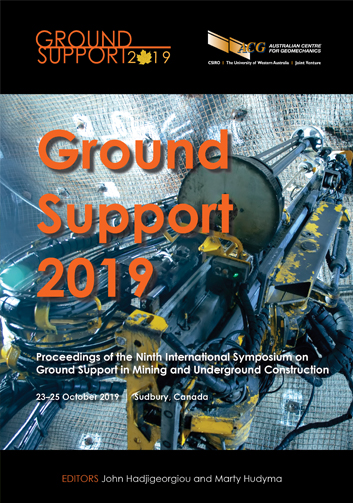Suppression of tunnel spalling by engineered rock mass damage

|
Authors: McDonald, AC; McKinnon, SD |
DOI https://doi.org/10.36487/ACG_rep/1925_33_McDonald
Cite As:
McDonald, AC & McKinnon, SD 2019, 'Suppression of tunnel spalling by engineered rock mass damage', in J Hadjigeorgiou & M Hudyma (eds), Ground Support 2019: Proceedings of the Ninth International Symposium on Ground Support in Mining and Underground Construction, Australian Centre for Geomechanics, Perth, pp. 471-478, https://doi.org/10.36487/ACG_rep/1925_33_McDonald
Abstract:
Near excavation boundaries in massive to moderately-jointed rock masses, rock predominately fails by extensional fracturing leading to the progressive formation of thin slabs of rock—referred to as spalls. These spalls can buckle, rotate, dilate and accumulate to cause bulking of the rock mass. Spalling can lead to overbreak, ground support damage and capacity consumption by bulking, and ejection of rock (strainbursting). Reliable design of deep excavations depends on reliable forecasts, which require informed understanding of the mechanisms of brittle failure and behaviour. Confinement has been used as a strategy to suppress spalling but this is not always possible. Alternatively, spalling can be suppressed by the accumulation of damage (whether engineered or naturally occurring) to the rock mass. Through an analogue model of a brittle rock mass, we show that engineering damage into the rock mass supresses and can theoretically prevent the occurrence of spalling around an underground excavation. Furthermore, we show that the bimodular ratio, related to the modulus of the intact rock in compressional versus extensional loading, is an important indicator of damage and proneness to strainbursting.
Keywords: spalling, strainbursting, elasticity, engineered damage, brittle rock
References:
Ashby, M & Hallam, S 1986, ‘The failure of brittle solids containing small cracks under compressive stress states’, Acta Metallurgica, pp. 497–510.
Basista, M & Gross, D 1998, ‘The sliding crack model of brittle deformation: an internal variable approach’, International Journal of Solids and Structures, pp. 487–509.
Bieniawski, ZT 1998, ‘The Rock Mass Rating (RMR) System (geomechanics classification) in engineering practice’, in L Kirkaldie (ed.), Rock Classification Systems for Engineering Purposes, ASTM International, West Conshohocken, pp. 17–34.
Fairhurst, C & Cook, N 1966, ‘The phenomenon of rock splitting parallel to the direction of maximum compression in the neighborhood of a surface’, Proceedings of the First Congress on the International Society of Rock Mechanics, International Society of Rock Mechanics, Lisbon, pp. 687–692.
Handin, J, Friedman, M, Logan, J, Pattison, L & Swolfs, H 1972, ‘Experimental folding of rocks under confining pressure: buckling of single‐layer rock beams’, Flow and Fracture of Rocks, pp. 1–28.
Hoek, E 1965, Rock Fracture Under Static Stress Conditions, National Mechanical Engineering Research Institute Council for Scientific and Industrial Research, Pretoria.
Hoek, E & Martin, C 2014, ‘Fracture initiation and propagation in intact rock – a review’, Journal of Rock Mechanics and Geotechnical Engineering, pp. 287–300.
Hoek, E, Carranza-Torres, C & Corkum, B 2002, ‘Hoek-Brown failure criterion – 2002 edition’, Proceedings of the Fifth North American Rock Mechanics Symposium and the 17th Tunnelling Association of Canada Conference, pp. 267–273.
Itasca Consulting Group Inc. 2012, FLAC3D Version 5.0: User's Guide, Minneapolis.
McDonald, AC 2019, Geological Controls on Strainburst Risk in Deep Mining Drifts, PhD thesis, in review, Queen’s University, Kingston.
Norwegian Geotechnical Institute (NGI) 2015, Using the Q System: Rock Mass Classification and Support Design, NGI, Oslo, 56 p.
© Copyright 2025, Australian Centre for Geomechanics (ACG), The University of Western Australia. All rights reserved.
View copyright/legal information
Please direct any queries or error reports to repository-acg@uwa.edu.au
View copyright/legal information
Please direct any queries or error reports to repository-acg@uwa.edu.au